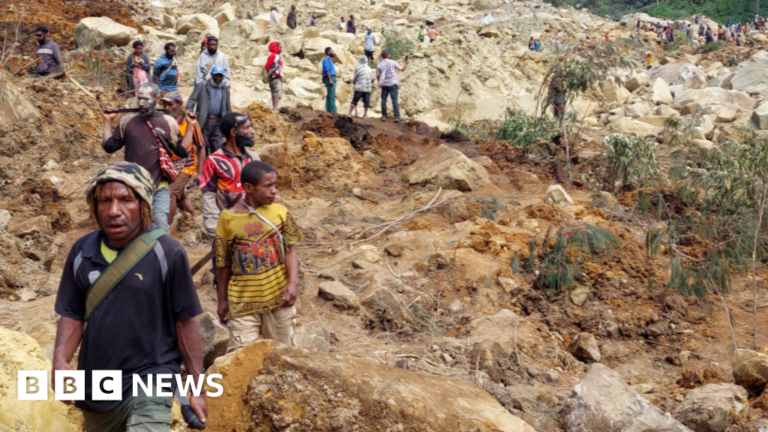- author, Francis Mao
- role, BBC News
-
A devastating landslide in Papua New Guinea that villagers have described as “like a bomb going off” may have buried more than 2,000 people alive, government agencies fear.
The figure, released by the acting head of the country’s National Disaster Management Centre, is far higher than the 670 deaths suggested by the United Nations over the weekend.
The exact death toll from the disaster, which struck the village early on Friday, is difficult to determine.
Desperate efforts to rescue survivors and retrieve bodies from the rubble have so far been hampered by debris 10 meters (32 feet) deep in places, preventing access and a lack of proper equipment.
But on the ground, hope is fading for residents in the disaster-hit mountain areas of Enga province.
“No one fled. We don’t know who died because the records are buried,” Jacob Sowai, a teacher from a nearby village, told AFP.
Standing among the wreckage stretching for nearly a kilometre, Ebit Kambu said he felt helpless.
“There are 18 family members buried under the rubble and dirt where I am standing – and countless more in the village,” she told Reuters.
Rasen Iso told local newspaper The National that the quake hit “like a bomb going off in an instant”, while Eddie Peter said he saw the quake rolling towards his home “like an ocean wave”.
“My husband returned while our four children were sleeping. I escaped, but they were all trapped and killed,” she told the paper.
Before the disaster, approximately 3,800 people lived in the area.
Lusete Raso Mana of the National Disaster Centre said in the letter that the damage was “enormous” and had “significantly affected the country’s economic lifeline”.
Prime Minister James Marape offered his condolences and ordered the deployment of defense forces and emergency services to the area, about 600 kilometers (370 miles) northwest of the capital, Port Moresby.
But residents of the affected village of Khao Kalam say they are still waiting for authorities to step in and launch a larger rescue operation.
A community leader who visited the scene told the BBC that locals felt left to fend for themselves, trying to rescue people using shovels and their bare hands.
“It’s been three or four days now. [many] “The bodies have not been found yet. They are still covered by the landslide and people are having a very hard time digging them out. They are asking the government for help and assistance,” Ignace Nembo told BBC’s Newshour programme.
However, a police official in the province told the BBC that soldiers had arrived at the scene and were seen trying to clear rocks to free those trapped.
Interim State Police Commander Martin Carey said these efforts are dangerous because removing rocks the size of cars and other large obstacles poses the risk of more rock slides.
“Excavation work is very difficult at the moment as there are fears of further landslides and fatalities, so locals are only digging from places they know are safe. We are trying to identify places where we know people are buried,” he said.
He has visited the site several times since Friday’s collapse and claimed he could still hear survivors crying out for help from beneath the rubble.
Local media reported that a couple was rescued alive from under the rocks, having survived because their home was only slightly damaged by the landslide.
They were rescued after rescuers heard cries for help, local television NBC News reported.
The remaining residents have been evacuated as further rain is expected and the area remains at high risk.
“The ground is also quite unstable at the moment which could lead to further landslides,” said Justine McMahon, country coordinator for CARE Australia, one of the humanitarian organisations on the ground.
“We have decided to remain on scene for the time being to allow authorities time to properly assess the situation and carry out rescue and recovery operations.”
Earlier, a UN migration official in the country had also spoken to the BBC about the difficulties surrounding the rescue.
Serhan Aktpurak, from the International Organization for Migration, said the challenges facing teams working to recover the bodies were numerous, including the reluctance of some grieving families to allow heavy machinery near their loved ones.
Instead, “people are using digging sticks, spades and large farm pitchforks to dig up bodies buried in the soil,” he said.
Respondents on the scene also said the only road into the town had been heavily damaged, hampering rescue efforts. McMahon said the landslide was about 200 metres (650 feet) long.
The Mount Mungaro landslide occurred in the Enga Highlands in the north of the island nation.
Local officials and reporters blamed the mountain’s collapse on weeks of heavy rain and other wet weather conditions in the area.
Reporting by Tiffany Turnbull in Sydney

